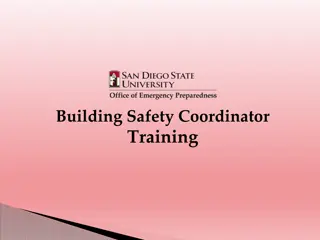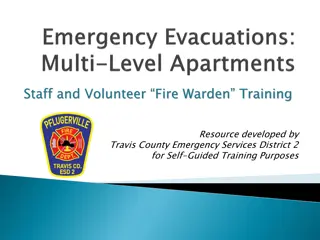Operating Room Fire Safety Guidelines
Response to operating room fires should be immediate. It is a shared responsibility of the surgical team to prevent fires by conducting annual fire safety education, following evacuation policies, and assessing fire risks in the OR. The AORN Fire Triangle highlights the elements necessary for a fire, emphasizing the importance of fire risk assessment and evacuation readiness practices. Individual duties in case of a fire include activating alarms, providing fire-suppressing materials, and preparing for evacuation if needed.
Download Presentation

Please find below an Image/Link to download the presentation.
The content on the website is provided AS IS for your information and personal use only. It may not be sold, licensed, or shared on other websites without obtaining consent from the author. Download presentation by click this link. If you encounter any issues during the download, it is possible that the publisher has removed the file from their server.
E N D
Presentation Transcript
OPERATING ROOM FIRE SAFETY
Purpose of this module The response to an Operating Room (OR) fire should be initiated within the second of discovery. Fire prevention is a shared responsibility of the entire surgical team. The surgical team needs to help each individual member of the team to carry out his or her responsibility. DNV requires annual WSRH operating room specific fire safety education.
Fire and/or Evacuation Policy The WSRH has a Fire and/or Evacuation Policy for Perioperative Service This applies to all staff within perioperative services The policy can be found on the WSRH Policy Repository
AORN FIRE TRIANGLE Fire is a risk to both patients and personnel in the OR because all three elements of the fire triangle that are necessary for a fire (fuel, oxidizer, ignition source) are present. Source: Guidelines for Perioperative Pracitce 2018, AORN: https://www.r2library.com/resource/detail/0939583046/ch0010s0150#got o=ch0010s0150fg0023
Fire Risk Assessment in OR Allow prep dry time of at least 3 minutes Which includes 10 minutes for hairy areas Document sources of ignition in the operating room Full acknowledgement and and documentation of fire safety risks during time out by surgical team
Evacuation Readiness Best Practices Do not block gas shut-off valves Do not block hallways; keep clear Do not block fire doors; keep clear
Fire Evacuation Route from OR Utilize discharge hallway Relocation or evacuation will always be away from the area affected by the fire emergency. ORs
Exit Routes ORs
Individual Duties: Individual Duties: Circulating Nurse Activate fire alarm by pushing Code Red Code Red in room Provide additional non-flammable liquids & drapes to smother the fire Turn off gas supplies as directed by Anesthesia Prepare for evacuation if necessary Obtain supplies for evacuation such as fire extinguishers, drapes, portable monitor, and available team members If equipment is smoking, turn off and disconnect power source Report event to Risk Management and complete Safety Report Reset fire code alarm
Individual Duties: Individual Duties: Scrub Person Remove drapes/burning material Douse with water from table Protect the patient
Individual Duties: Individual Duties: Anesthesia Provider Stop flow of breathing gases to patient Switch to portable gases Direct OR personnel to turn off gas supplies
Individual Duties: Individual Duties: Surgeon Stay with patient Control hemorrhage Prepare for evacuation if necessary
Individual Duties: Individual Duties: OR Assistant Nurse Manager and OR Charge Nurse Code red Code red will send alert to all of working circulators of OR fire and location on ASCOM phones. Code red will automatically notify facilities, security, and the Perioperative Nurse Manager of the fire and the location OR desk will act as command post. Direct outside help as necessary by communicating needs (traffic controller) Communicate with other OR rooms as needed
Individual Duties: Individual Duties: Ancillary Personnel Clear hallways Clear room Post ALL CLEAR signs as appropriate Assist with moving Obtain fire extinguishers Located by Room 3, Room 4, and in the main OR hallway by the door to the core
Individual Duties: Individual Duties: Receptionist/Surgical Waiting Reassure family as necessary Surgical waiting area and offices will be checked and cleared by the receptionist
Individual Duties: Individual Duties: PACU/Pre-Op Techs Nursing techs will split the Pre-Op Unit and clear any empty rooms by checking the room, shutting the door, and placing an orange cone outside of the room. Orange cones are located in each room. Once the empty rooms have been cleared, nursing techs will assist nursing staff with any assigned tasks
Individual Duties: Individual Duties: Perianesthesia Assistant Nurse Manager or Perianesthesia Charge Nurse Perianesthesia Assistant Nurse Manager or Perianesthesia Charge Nurse will keep open communication with all other units in reference to fire plan and help Perioperative Team as needed
Individual Duties: Individual Duties: PACU/Pre-Op Staff Nurses Staff nurses will direct family members and visitors to exit the building Staff nurses will reconnect patients using wall O2 to the portable O2 tank under the stretcher
All Perioperative Staff All Perioperative Staff Will remain within the fire wall until the fire alarm is clear If a shelter in place/evacuation is called, all staff will assist in the evacuation of all patients in the safest manner possible
For a fire in an adjacent or nearby room For a fire in an adjacent or nearby room while surgery is in progress while surgery is in progress Seal off room with wet blankets Disconnect all electrical equipment
Thank you Working as One Working as One























